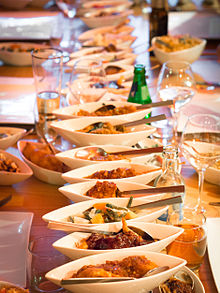 An elaborate rijsttafel in a restaurant in The Hague, Netherlands | |
| Alternative names | Rice table |
|---|---|
| Course | Main course |
| Place of origin | Indonesia |
| Region or state | Indonesia, Netherlands and Belgium |
| Serving temperature | Hot or room temperature |
| Main ingredients | Rice with various side dishes |
| Variations | nasi campur, nasi rames (Indo) |
| Other information | It is more a lavish banquet than a dish, popular in the Netherlands |


Rijsttafel (/ˈraɪstɑːfəl/ RY-stah-fəl, Dutch: [ˈrɛistaːfəl] ), a Dutch word that literally translates to "rice table", is an Indonesian elaborate meal adapted by the Dutch following the hidang presentation of nasi padang from the Padang region of West Sumatra.[1] It consists of many (forty is not an unusual number) side dishes served in small portions, accompanied by rice prepared in several different ways. Popular side dishes include egg rolls, sambals, satay, fish, fruit, vegetables, pickles, and nuts. In most areas where it is served, such as the Netherlands, and other areas of strong Dutch influence (such as parts of the West Indies), it is known under its Dutch name.
Although the dishes served are undoubtedly Indonesian, the rijsttafel’s origins were colonial. The Dutch introduced the rice table not only so they could enjoy a wide array of dishes at a single sitting but also to impress visitors with the exotic abundance of their colony.[2]
Rijsttafels strive to feature an array of not only flavors and colors and degrees of spiciness but also textures, an aspect that is not commonly discussed in Western food. Such textures may include crispy, chewy, slippery, soft, hard, velvety, gelatinous, and runny.